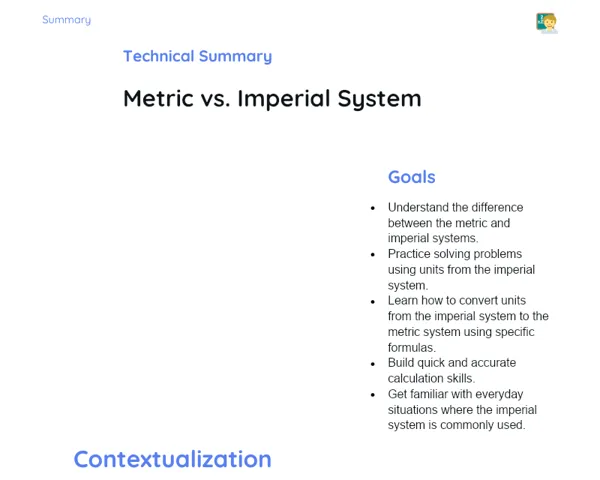Summary Tradisional | Linear Systems: Resolution
Contextualization
Linear systems comprise two or more linear equations that involve two or more variables. These equations are solved together to find the values of the variables that meet all equations simultaneously. Mastering the solving of linear systems is a crucial skill in algebra and has applications across various disciplines such as engineering, economics, and computer science. Grasping the techniques for solving these systems is vital in tackling intricate problems that involve multiple variables.
In real-life scenarios, linear systems help model situations like transportation route planning, electrical circuit simulations, and economic data analysis. For instance, in engineering, linear systems can be leveraged to determine forces in a structure, while in economics, they assist in predicting financial market trends. Hence, efficiently solving linear systems equips students with a robust tool to apply mathematical concepts to real-world complexities.
To Remember!
Concept of Linear Systems
A linear system is defined as a set of two or more linear equations entailing two or more variables. These equations are resolved simultaneously to identify the variable values that fulfil all equations concurrently. Linear systems can be categorized based on their solutions into three types: independent consistent systems (one unique solution), dependent consistent systems (infinite solutions), and inconsistent systems (no solution).
In a linear system, each equation signifies a line (in two dimensions) or a plane (in three dimensions), while the system’s solution corresponds to the intersection point of these lines or planes. For example, a set of two linear equations with two variables can be depicted as two lines on the Cartesian plane, with the solution being the point where these lines intersect.
Solving linear systems serves as a foundation in algebra and has a wide range of applications in fields like engineering, economics, and computer science. Familiarity with solving methods is essential for addressing complex problems involving multiple variables, enabling the modeling and analysis of real-world contexts.
-
A linear system consists of two or more linear equations with two or more variables.
-
Linear systems can have one solution, infinitely many solutions, or no solution.
-
The solution to a linear system is the intersection point of the lines or planes represented by the equations.
Cramer's Method
Cramer’s Method is an algebraic technique that employs determinants to solve linear systems. This method is applicable to square linear systems, where the number of equations equals the number of variables. To utilize Cramer’s Method, one must compute the determinant of the system's coefficient matrix and the determinants of matrices formed by substituting one column of the coefficient matrix with the constant terms of the equations.
The general formula for Cramer’s Method in a 2x2 system is expressed as x = D_x/D and y = D_y/D, where D stands for the determinant of the coefficient matrix, D_x denotes the determinant of the matrix obtained by replacing the coefficient column of x with constant terms, and D_y represents the determinant of the matrix derived by substituting the coefficient column of y with constant terms. For 3x3 systems, a similar yet more intricate formula applies involving determinants of 3x3 matrices.
Though Cramer’s Method is a powerful technique, it can become computationally heavy for larger systems. Furthermore, this method is only applicable when the determinant of the coefficient matrix is non-zero; otherwise, the system may be inconsistent or possess infinite solutions.
-
Cramer's Method employs determinants to solve square linear systems.
-
It is necessary to calculate the determinant of the coefficient matrix along with the determinants of matrices modified by replacing columns.
-
This method can only be used if the determinant of the coefficient matrix is non-zero.
Row Echelon Method (Gaussian Elimination)
The row echelon method, also referred to as Gaussian elimination, is a strategy that transforms a linear system into echelon form through elementary row operations. These operations include swapping rows, multiplying a row by a non-zero number, and adding a multiple of one row to another. The objective of the row echelon method is to derive an upper triangular matrix or a diagonal matrix, enabling simpler resolution of the system through back substitution.
To implement the row echelon method, you start with the augmented matrix of the linear system. Elementary row operations are then employed to convert the matrix into echelon form. Once in echelon form, the linear system is solved from the last equation (featuring one variable), substituting the known values into preceding equations.
This method is efficient and widely relied upon for solving linear systems of any size. It is also foundational for other numerical techniques like LU decomposition. However, users should be cautious of rounding errors that can arise in numerical calculations, especially in larger systems.
-
The row echelon method reformats a linear system into echelon form using simple row operations.
-
The aim is to arrive at an upper triangular or diagonal matrix to simplify solving the system.
-
It's an efficient approach for addressing linear systems of any size, but it can be sensitive to rounding errors.
Substitution Method
The Substitution Method is a straightforward technique for solving linear systems, especially suited for systems with two or three equations. In this approach, an equation is solved for one variable, and the resulting expression is substituted into the other equations. This process is repeated until all variables are determined.
To apply the Substitution Method, select one equation and isolate a variable. The isolated expression is then incorporated into the other equations, which results in a new system with one fewer equation. This iterative process continues until you achieve an equation with a sole variable that can be solved directly. The obtained values are subsequently substituted back to ascertain the other variables.
The Substitution Method proves particularly advantageous when one equation is straightforward, allowing for easy isolation of a variable. However, it may become cumbersome and susceptible to errors when dealing with larger or more complex systems. Additionally, this method is not appropriate for inconsistent systems or those with infinite solutions.
-
The Substitution Method involves isolating a variable and substituting the resulting expression into other equations.
-
It is notably useful for systems comprising two or three equations.
-
It can become unwieldy and error-prone when applied to larger or more complex systems.
Key Terms
-
Linear Systems: A set of two or more linear equations with two or more variables.
-
Cramer's Method: An algebraic approach using determinants to solve square linear systems.
-
Row Echelon: A procedure that transforms a linear system into echelon form through elementary row operations.
-
Gaussian Elimination: The alternative name for the row echelon method.
-
Substitution Method: A technique for solving linear systems by isolating a variable and substituting the resulting expression into other equations.
-
Addition Method: A method that solves linear systems by either adding or subtracting equations to eliminate a variable.
-
Determinants: Values derived from matrices utilized in methods like Cramer's.
-
Matrices: Rectangular arrangements of numbers that represent linear systems.
-
Problem Solving: The process of identifying solutions for linear systems using algebraic techniques.
Important Conclusions
In this lesson, we've delved into the fundamental concepts and methods for solving linear systems, which encompass sets of linear equations with multiple variables. We've examined Cramer's Method, which harnesses determinants for solution finding, and the row echelon method, popularly known as Gaussian elimination, which restructures the system into an echelon form for easier resolution. Additionally, we've touched upon the Substitution Method, which is beneficial for smaller systems.
The significance of mastering these techniques cannot be emphasized enough, as linear systems are critical in various sectors like engineering, economics, and computer science. The ability to efficiently resolve these systems aids in the modeling and analysis of real-life situations, making it a vital component of students' mathematical arsenal.
Lastly, comprehending and properly employing these methods is pivotal for addressing intricate problems with multiple variables. We suggest students practice consistently and explore the topic further, as mastering these concepts will unlock deeper insight into mathematical challenges and their applicable contexts.
Study Tips
-
Revisit the fundamental concepts of matrices and determinants, as they are key to understanding and applying Cramer's Method.
-
Engage in solving linear systems through different methods to determine which is most efficient for varying scenarios.
-
Explore practical problems in industries like engineering and economics to apply linear systems solving methods and appreciate their real-world implications.



